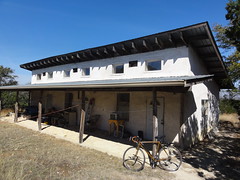| Building a straw-bale house. (Photo credit: Wikipedia) |
1. Reduce your carbon footprint
The straw used in straw bale structures is entirely contained in the wall, which means that the carbon absorbed while the straw was growing as wheat, oats, or other grains will not be released into the atmosphere. Also, straw bale construction uses a common waste product, straw, that would normally be burned or otherwise disposed of. Finally, using straw decreases the need for other natural resources, particularly lumber.
2. Fire resistance
It may seem counter-intuitive, but straw bales are actually more fire resistant than the average lumber house. Why? The bales are packed so tightly that not enough oxygen penetrates them to feed a fire. Fire tends only to smolder in straw bales, rather than going up in flames.
3. Insulation
The real savings in straw bale structures is in energy costs. Straw makes an excellent insulation against temperature and noise. People who are building near an airport or highway may want to consider straw bale construction.
4. Save on labor costs
Straw bales are easy to stack, like big blocks, which means a "work party" of volunteers can help build your structure for much less money than a typical contractor.
| Straw Bale House (Photo credit: Todd Dwyer) |
Unlike flake board, plywood, drywall, fiberglass insulation, and other building materials, straw contains no artificial chemicals and won't outgas any harmful fumes.
6. Termites don't like it
Termites just don't find straw palatable. Unlike hay, straw has no food value to termites or other vermin.
7. No allergy worries
Also unlike hay, straw has no leftover flower or plant parts and thus no pollen. That's why certain allergic reactions are called hay fever, not straw fever!
Straw bale construction is worth considering, especially if you live in a climate with temperature extremes or in an area with a great deal of noise. And last but not least, when covered with smooth plaster, straw bale constructions are very attractive. While this method of building construction may be new to you, as you can see there are many benefits, and in some cases it can be a very economical and environmentally friendly choice.



No comments:
Post a Comment